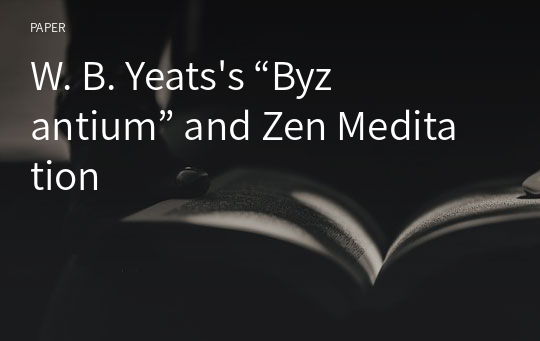W. B. Yeats's “Byzantium” and Zen Meditation
* 본 문서는 배포용으로 복사 및 편집이 불가합니다.
서지정보
ㆍ발행기관 : 한국예이츠학회
ㆍ수록지정보 : The Yeats Journal of Korea / 35권
ㆍ저자명 : Yoo, Baekyun
ㆍ저자명 : Yoo, Baekyun
목차
Works CitedAbstract
영어 초록
In this study, I will focus on “Byzantium” and explore how the poem mirrors the essence of Zen Meditation. Not only is the poem patterned after the progressive procedure of Zen meditation, but they also reflect the fundamental concerns of Zen meditation, such as the problem of duality, the concept of time, and an aspiration for freedom from the limitation of this life. These features of Zen meditation are expressed through the use of specific symbols, the implications of setting, and various poetic techniques. The purpose of this study is to provide another way to read the poem by analyzing it in the context of Zen meditation. The structures of the poem are loosely patterned after a typical process of meditation through which the meditator reaches Unity of Being. The process of Zen meditation is nicely depicted in the ten pictures titled “The Boy and the Ox,” each of which shows the gradual development of the meditator’s search for his won nature or Buddhahood. For the convenience of my discussion, I will simplify the ten stages of Zen meditation to four−confusion, immersion, union and return−which, I believe, cover all the important procedures in the meditation. The first stanza of “Byzantium” exhibits some typical features related to its meditative scheme, in which we can feel the sense of confusion on the part of the meditator or poetic persona. In other words, the meditator sets out his meditative journey to search for an answer for his sense of confusion or clear it. The second to the fourth stanzas are equivalent to the second stage (immersion) and the third stage (union or seeing the vision) of meditation. The last stanza parallels the final stage of Zen meditation (return). In “Byzantium,” we see the reflection of Zen meditation. The structural patterns of the meditative poems generally correspond to the four stages of Zen meditation: confusion, immersion, union or seeing the vision of the unity, and return. Yeats’ use of poetic techniques such as line scheme, use of number symbolism, and the arrangement of stanzas are closely associated with the meditative scheme of the poems. In addition, the major concern of the poems is reminiscent of that of Zen meditation in that they confront the problem of duality, which sets up the occasion for meditation. The agony of duality results from the concept of time. Thus, the meditator tries to reconcile the dichotomous elements, resulting in the state of freedom from time. More than anything else, the purpose of Yeats’ meditative poem lies in the poet’s aspiration for self-awakening, as in Zen meditation. The poem is Yeats’ record of his life-long efforts to meet his “fourth self” or Great Self.참고 자료
없음태그
"The Yeats Journal of Korea"의 다른 논문
 Michael Wood, Yeats and Violence. (Oxford: Oxford UP, 2..3페이지
Michael Wood, Yeats and Violence. (Oxford: Oxford UP, 2..3페이지 The Authentic Power of Debunking Literature: Focusing o..16페이지
The Authentic Power of Debunking Literature: Focusing o..16페이지 Old Age and Art in Yeats18페이지
Old Age and Art in Yeats18페이지 Perfection of Art in Yeats and Joyce: “Leda and the Swa..22페이지
Perfection of Art in Yeats and Joyce: “Leda and the Swa..22페이지 비잔티움 시편에 나타난 현실과 이상22페이지
비잔티움 시편에 나타난 현실과 이상22페이지 비잔티움을 넘어서: 예이츠의 후기시에 나타난 초월의 문제 연구24페이지
비잔티움을 넘어서: 예이츠의 후기시에 나타난 초월의 문제 연구24페이지 예이츠와 소포클레스의 오이디푸스28페이지
예이츠와 소포클레스의 오이디푸스28페이지 예이츠는 그의 『환상록』에서 무엇을 하고 있나?15페이지
예이츠는 그의 『환상록』에서 무엇을 하고 있나?15페이지 예이츠 초기시의 상징주의와 마스크 이론의 갈등36페이지
예이츠 초기시의 상징주의와 마스크 이론의 갈등36페이지 메타시학으로 본 예이츠 시 「레다와 백조」30페이지
메타시학으로 본 예이츠 시 「레다와 백조」30페이지


























